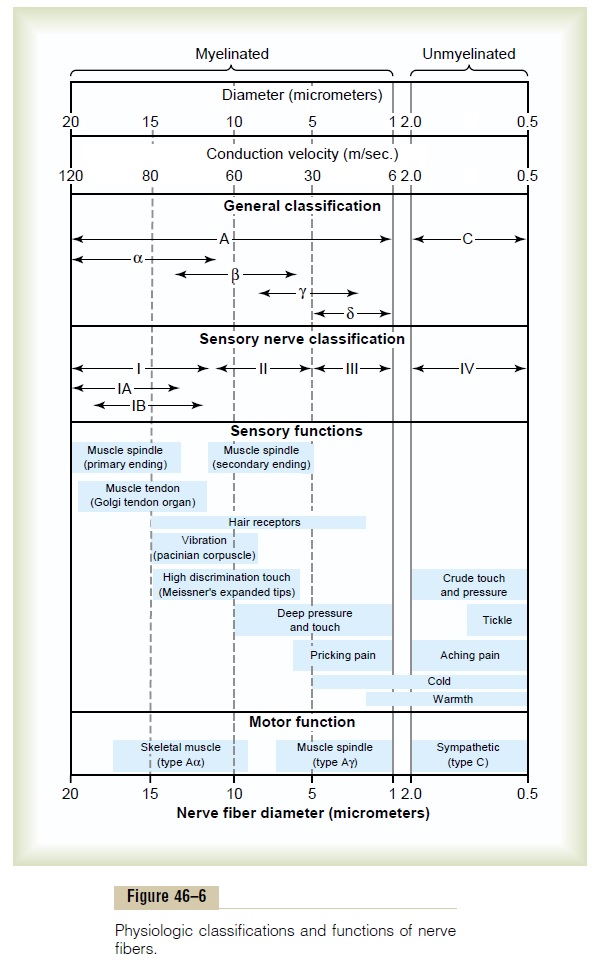Chapter: Medical Physiology: Sensory Receptors, Neuronal Circuits for Processing Information
Nerve Fibers That Transmit Different Types of Signals, and Their Physiologic Classification
Nerve Fibers That Transmit Different Types of Signals, and Their Physiologic Classification
Some signals need to be transmitted to or from the central nervous system extremely rapidly; otherwise, the information would be useless. An example of this is the sensory signals that apprise the brain of the momen-tary positions of the legs at each fraction of a second during running. At the other extreme, some types of sensory information, such as that depicting prolonged, aching pain, do not need to be transmitted rapidly, so that slowly conducting fibers will suffice. As shown in Figure 46–6, nerve fibers come in all sizes between 0.5 and 20 micrometers in diameter—the larger the diame-ter, the greater the conducting velocity. The range of conducting velocities is between 0.5 and 120 m/sec.

General Classification of Nerve Fibers. Shown in Figure 46–6is a “general classification” and a “sensory nerve classi-fication” of the different types of nerve fibers. In the general classification, the fibers are divided into types A and C, and the type A fibers are further subdivided into a, b, g, and d fibers.
Type A fibers are the typical large and medium-sized myelinated fibers of spinal nerves. Type C fibers are thesmall unmyelinatednerve fibers that conduct impulses at low velocities. The C fibers constitute more than one half of the sensory fibers in most peripheral nerves as well as all the postganglionic autonomic fibers.
The sizes, velocities of conduction, and functions of the different nerve fiber types are also given in Figure 46–6. Note that a few large myelinated fibers can trans-mit impulses at velocities as great as 120 m/sec, a distance in 1 second that is longer than a football field. Conversely, the smallest fibers transmit impulses as slowly as 0.5 m/sec, requiring about 2 seconds to go from the big toe to the spinal cord.
AlternativeClassificationUsedbySensoryPhysiologists Certain recording techniques have made it possible to separate the type Aa fibers into two subgroups; yet these same recording techniques cannot distinguish easily between Ab and Ag fibers. Therefore, the fol-lowing classification is frequently used by sensory physiologists:
Group Ia
Fibers from the annulospiral endings of muscle spindles (average about 17 microns in diameter; these are a-type A fibers in the general classification).
Group Ib
Fibers from the Golgi tendon organs (average about 16 micrometers in diameter; these also are a-type A fibers).
Group II
Fibers from most discrete cutaneous tactile receptors and from the flower-spray endings of the muscle spin-dles (average about 8 micrometers in diameter; these are b- and g-type A fibers in the general classification).
Group III
Fibers carrying temperature, crude touch, and pricking pain sensations (average about 3 micrometers in diame-ter; they are d-type A fibers in the general classification).
Group IV
Unmyelinated fibers carrying pain, itch, temperature, and crude touch sensations (0.5 to 2 micrometers in diameter; they are type C fibers in the general classifi-cation).
Related Topics